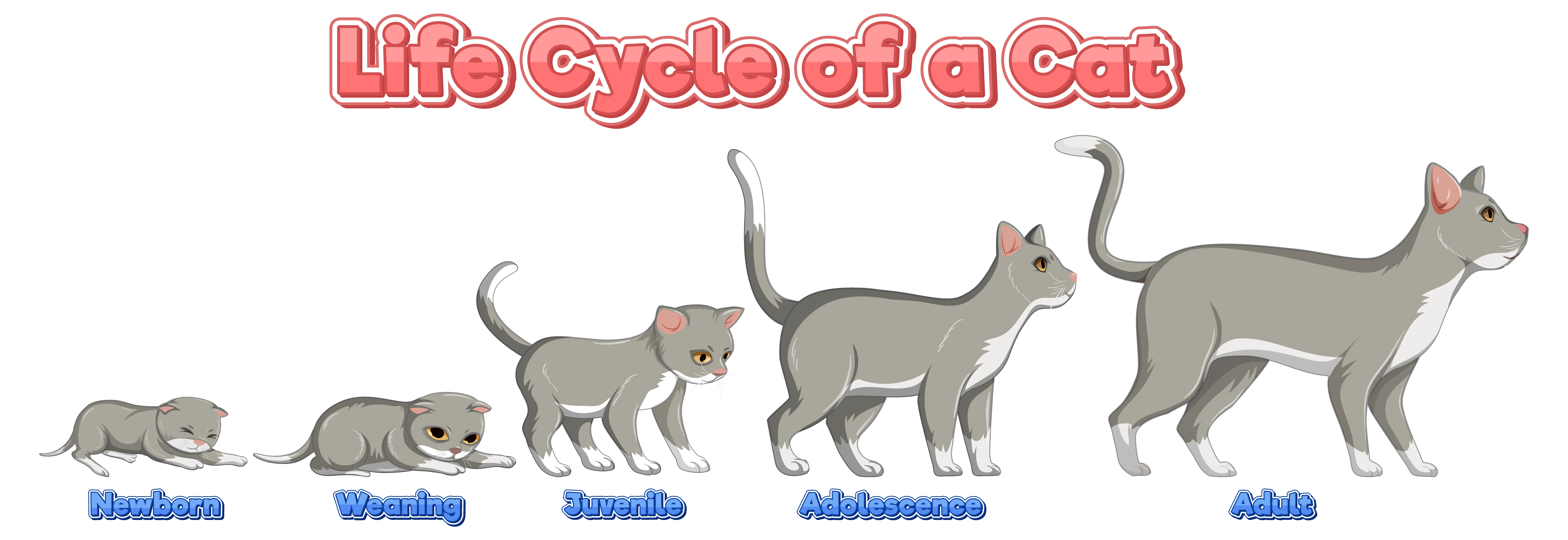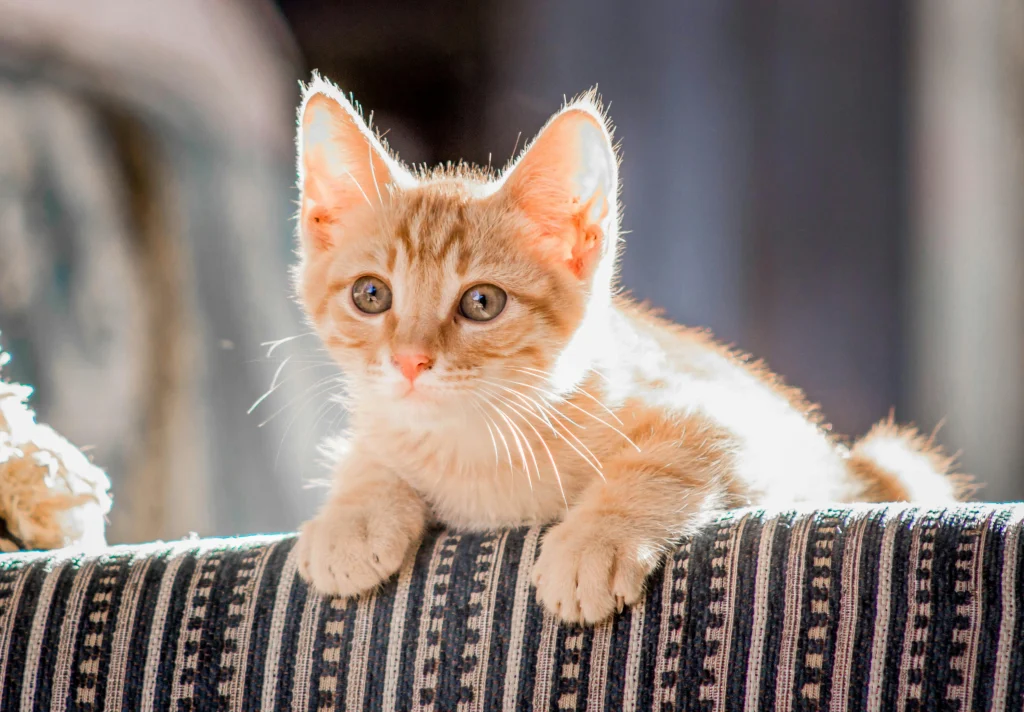Cats come in all shapes and sizes, and they are cute regardless. Some cats can be smaller than average, and you may wonder: Why is my cat small?
The size of the cat can depend on its age, breed and health. While it is normal for a kitten of a certain age to be tiny, what if you don’t know your cat’s background and age? Especially if it’s a rescue cat or a shelter kitty. In this article we will explore why cats can stay small and when that is a normal occurrence.
Why Is My Cat Small?
There are several factors affecting your cat’s growth, the reason why your cat is small can be due to a combination of the following things: the cat’s breed, genetics, biological sex, age, nutrition and genetic conditions. All of these factors combined can result in a cat being smaller than average. Female cats tend to be smaller due to sexual dimorphism in cats, but it can also be due to genetic and nutritional factors. If you are concerned about your cat’s health when it comes to their size, it is best to consult your veterinarian.
Do Some Cats Just Stay Naturally Small?
Cats can be small because of several reasons. Due to their age, breed, gender, and how much nutrition the kitty received in its early stages. The “smolness” can also be due to genetic mutations and dwarfism. But we will get into that in a bit.
- Cat’s age
- Cat’s gender
- Breed
- Genetics
- Nutrition
- Genetic mutations
How Cat’s Age Affects Size
Is it normal for your cat to be small if they are under 12 months old? Yes. Cats typically stop growing around 12-16 months of age. So if it has some kitten features such as a small head and wide paws, the reason why your cat is small is because they are likely still growing. However some cat breeds such as the Maine Coon continue to grow until they are 4-5 years old.
If you are not sure of your cat’s age, you can consult with a veterinarian to tell you approximately your cat’s age. But it would still be an estimation. You can sometimes tell a cat’s age by their teeth, a kitten’s canine teeth are much smaller compared to an adult cat’s teeth. Kitten teeth usually fall out just like in humans, after a few months they will be replaced by adult cat teeth.

How Gender Impacts Your Cat’s Growth
A cat’s size is also largely dependent on the cat’s gender. Female cats tend to be smaller than males. Sexual dimorphism in cats shows by males being slightly larger than females, as well as males having wider cheeks due to all the testosterone. The individual hormonal levels can determine the cat’s size. Female cats being smaller in size has its advantages for hunting, they can have more agility which is crucial when they are caring for their kittens.
Cat Breeds Known for Smaller Sizes
As an adult cat, your cat can simply be naturally of smaller size. Or it can be one of the following breeds:
- Singapura
- Munchkin
- Siamese
- Devon Rex
- Japanese bobtail
- Cornish Rex
These are some of the smallest cat breeds existing today. Notably, the Singapura is considered to be the smallest cat breed because as an adult, they weigh between 1.8-2.7kg (4-6 pounds). Munchkins also appear to be on the smaller side, mostly because of their shorter legs. As adults they reach around 2.3-4kg (5-9 pounds). If you prefer smaller cat breeds, check out our article on Best 6 cat breeds for small apartments.
How Genetics Influence a Cat’s Size
Cat’s appearance, fur color, eyes color and size largely depends on their genetics. While there is no certainty that kittens from 2 cat parents will receive all of their same traits, kittens would inherit a size related gene. If both cat parents are on the smaller size, there is a higher chance that the kittens will not be huge either. However, nutrition of the mother cat and the kittens plays a big role in the final size as well.
Nutrition’s Influence on a Cat’s Growth
If the kitten has not received sufficient nutrition and activity, their growth can be stunted as well. Kittens grow very rapidly and in the first months they need their calories. The cat mother’s milk provides them with all of their nutritional needs up to 4 weeks. After 4 weeks, between 4-6 weeks, meat can be introduced into the kittens’ diet. If the kitten was not nursed adequately in the first few weeks of its life, it can affect their final size as adults. Of course adult cats need sufficient nutrition as well or else it impacts their health.

How Genetic Conditions Make Your Cat Small
Random genetic mutations can sometimes occur that cause shorter size for cats. If you are worried that your cat’s health is at risk based on their size or weight, it would be good to consult a veterinarian. Other than that, there are cat ancestry testing kits that can tell you more about your cat’s genetic background. These types of tests can help rule out predisposition to certain genetic diseases. For example the Breed + Health Cat DNA Test by Basepaws, a company that provides wide insight into your pet’s genetic blueprint. They also have these testing kits for dogs.
Does Your Small Cat Have Dwarfism?
The reason why your cat is small could also be because it has dwarfism. For example the Munchkin cat breed has a type of dwarfism called achondroplasia, which specifically affects the length of their limbs. Other than reduced agility (they cannot jump as high as cats without the condition), the Munchkin cat breed is considered to be fairly healthy. If your cat is not part of the Munchkin breed but you are starting to notice reduced growth in your cat, only the veterinarian can confirm whether your cat has dwarfism.
Should I Be Worried if My Cat is Small?
Unless your cat doesn’t seem to have visible health issues or something else may be involved, a smaller cat size on its own is not a reason for concern. Small cats can still live a healthy life even if they are more compact than your expectations. But it is best to confirm with your veterinarian if the reason for their size is their age and gender, or there is some other cause.
Can Cats Be Naturally Small?
Yes, cats can be naturally small due to their genetics, gender and age. If your cat is part of the listed smaller cat breeds, then they likely have the genes that determine their smaller size.
How Long Will My Cat Stay Small?
Is your cat still a kitten? Then they will likely grow into their adult size by the time they are 12 months old. Cats are so cute when they are small, and we may wish it would last forever but that time will fly. If you provide essential nutrition and feed your cat according to its age, your small little fluffball will reach its final adult height and size within a year.
Is My Cat a Dwarf or Just Small?
Only a vet can tell if your cat might have dwarfism or if they are just naturally small. There may be visual differences in a smaller sized cat compared to a cat that has dwarfism. Typically cats with dwarfism have different body-to-limbs proportions, while a naturally small cat can still have proportionate limb length compared to their body size.

How Is Dwarfism in Cats Diagnosed?
Usually the signs of dwarfism in cats can be observed visually. But your vet can also take blood and urine samples to determine if there are other conditions involved. A diagnosis can also include noting genetic history, x-rays of limbs and spine. These are the most common visual signs of dwarfism in cats:
- The head is larger than the rest of the body
- Short nose, usually seen with a jaw that sticks out more than the upper jaw
- Unusually shaped bones
- A shorter jaw, which can lead to misaligned teeth
- Shorter-than-usual limb bones
- Joints that seem enlarged or swollen
- Insufficient overall growth of the body
- A spine that is curved or misaligned
- Front legs that bend outward, commonly seen in the forelimbs
If you notice these signs in your feline friends, do not hesitate to reach out to your veterinarian. They can confirm your suspicions and provide you with resources on how to care for your shorter kitty friend.
How Do I Care For a Dwarf Cat?
Despite several health risks involved with the condition, your cat with dwarfism can live a pretty happy life. Of course this involves monitoring their health with regular vet check-ups to ensure the cat’s wellbeing. There are several considerations you would need to be aware of when it comes to caring for cats with dwarfism. Such as but not limited to:
- Feeding habits
- Size-appropriate exercise
- Risk of arthritis
- Accessibility
- Mental stimulation
When it comes to kitties with dwarfism, it is important to monitor how much they are fed. It is not recommended to allow them to free-feed as it can lead to obesity, and put additional strain on their joints. These cats’ reduced activity levels may make them more susceptible to weight gain. That is why it is crucial to ensure they kitty is receiving a balanced healthy meal in controlled portions.
When it comes to exercise, Munchkins and cats with the dwarfism condition have different needs. They cannot jump as high or as far. So a normal cat tree would not be the best choice. Look for cat furniture that has a lower base. You might want to have a ramp or steps next to the furniture or areas you’d want them to access. You can create a space for your munchkin that allows them to jump shorter distances, and is appropriate for their abilities.
Other items need to be thought of when it comes to accessibility. Consider getting a litterbox with shorter sides, or the type of litterbox that has a ramp or steps. Alternatively you can get a ramp separately and fix it next to the litterbox.
Another risk with dwarf cats is arthritis. It is fairly common among cats with dwarfism. Consider providing your cat with supplements for their joints as a preventative treatment. It can help strengthen their joints and hopefully prevent arthritis. Consult with your veterinarian for the best options to care for your kitty.
If you are curious about the topic, you can read more about it here: Cat Health: Dwarfism in cats
The Summary of Why Your Cat is Small
To summarize the answer to the question Why your cat is small, it is likely due to genetics, age and gender. The breed of the cat includes genes that can also affect its final size. Female cats are typically smaller than male cats because of hormonal differences and sexual dimorphism. If a cat has a genetic condition such as dwarfism, this also makes their limbs shorter.
Before 12 months of age, a cat is usually still growing, so if your cat is very small it could be because they are still only a few months old. At the end of the day, nutrition plays a huge part too. If the mother cat had enough nutrition during pregnancy and after the kittens started nursing. If the kittens did not get enough nutrition throughout their kittenhood, that can impact their growth as well. We also have some cool takeaways for new cat owners here.
All in all, a cat being small can be a very normal and sometimes temporary thing. Cats are cute regardless of their size and we should provide them with the best care according to their needs.

